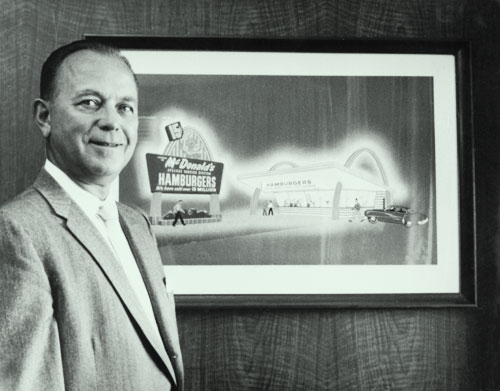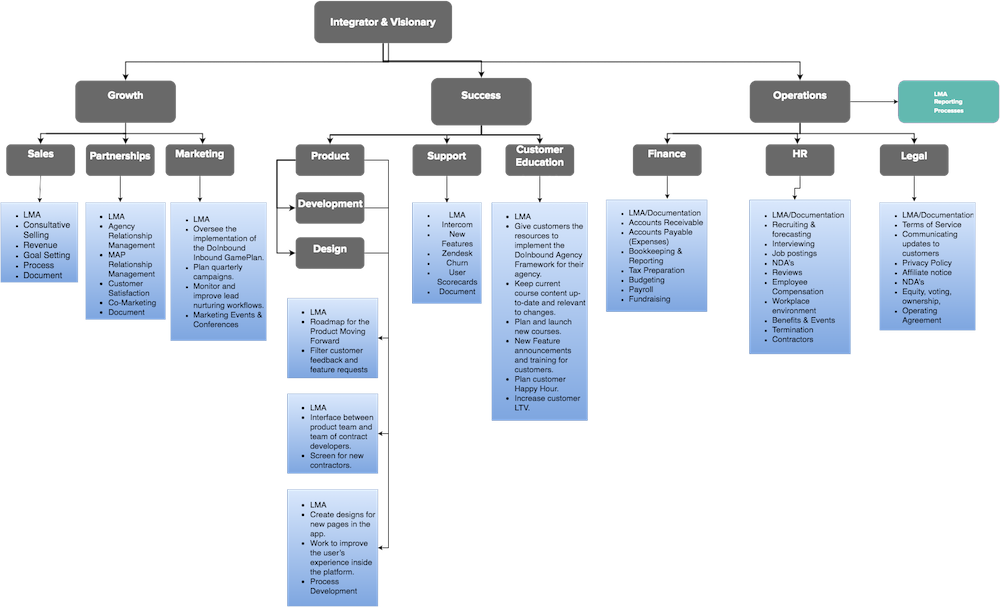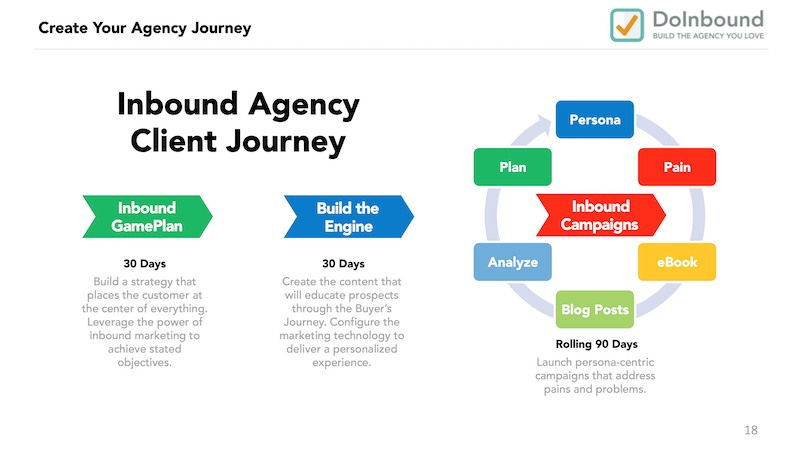
In 1955, a middle-aged milkshake machine salesmen came upon something odd.
At a time when his industry was taking a dive, one restaurant ordered enough machines to make 40 milkshakes at once. He was so curious that he bought a plane ticket and flew from Illinois to California to see what kind of restaurant would make such a purchase.
What he discovered would change the world forever. When Ray Kroc walked into the McDonald brothers’ restaurant in San Bernardino, California, he was blown away. Unlike the popular drive-ins of the time, McDonald’s only sold hamburgers, cheeseburgers, fries, drinks, and milk shakes. Its narrow offerings were all produced in an assembly-line-style system.

Immediately, Kroc envisioned opening up a thousand of these little restaurants across the country. When he found out that the McDonald’s brothers weren’t interested in pursuing the idea alone, Kroc bought the rights to the McDonald’s method.
It wasn’t the quality of the fries and the burgers that made McDonald's valuable; it was the system and processes they had created. And the rest is history.
An Inbound Marketing Agency Is No Different
Michael Gerber, author of The E-Myth Revisited, writes, “If you are going to create a business that serves your life, you must create an organization that will stand on its own. You need a model that is systematized so that it functions the same way every time.”
For an inbound marketing agency to grow into a robust business, there needs to be systems in place that manage delivery. These systems should be driven by standardized individual processes.
It doesn’t matter if you’re a one-man shop or a thriving agency with a full-time staff, it’s critical to document every aspect of your operation.
If processes only exist in your head and in the minds of your team members, then business growth is capped by your team’s existing capacity.
Marisa Smith knows what it feels like to build a business that is capped by her existing capacity. Smith's story as the CEO of Whole Brain Group is a story of survival and discovery.
When the economy took a turn for the worse in 2008, she shifted the focus, and the agency became primarily a WordPress web design agency. This move proved to be the right one.
After success with early clients, she then expanded the agency's services into social media marketing.
But she soon realized something wasn't working. Projects were great, but there was no way to forecast revenue. The business was growing, but capacity wasn't expanding.
It was time for another shift.
This time, Whole Brain Group shifted toward inbound. They wanted to offer a well-rounded suite of services to their clients. They also wanted to have a better idea of what their agency income would look like.
This shift brought with it the move to the retainer model.
Where Is That Greener Grass?
Each shift or change in business practices an agency goes through brings the optimism of a new opportunity. Leaders say things to themselves such as, "Things will be different this time" and "We won't make the same mistakes we did in the past." This mindset helps for a while, but soon they discover that reality isn't that easily changed.
And when success happens, it can cause the core issues that were never solved to become even more pronounced. The more you grow, the faster you eat away at your capacity. With no overflow space, it's only a matter of time until the system starts to break down.
Smith and the core team at Whole Brain Group felt this. Although they were experiencing some success, they knew there was a better way out there.
What they were missing was clarity.
It is hard for a team to hit a target when everyone is shooting at a different mark.
Marisa set out on a mission to create clarity with her core team and get everyone rowing to the same rhythm.
Maximizing the Power of a Team
Rowing is a beautiful sport.
Driving into Philadelphia from the north, you take Schuylkill Expressway. The traffic on this highway is horrendous. The only positive part of the experience is the view.
As you approach the city, you get a view of historic Boathouse Row. For years this has served as the center for rowing life in America.

If you drive past at the right time of day, you can see a team practicing on the still water. It's almost magical.

Each member of the team fits into their seat.
Each knows their job.
Each performs their role.
Each knows the roles of their teammates.
It is by maintaining perfect unity that the boat crew maximizes their efforts. It is only when they hit the perfect rhythm together that they can achieve their goals.
If just one rower moves out of rhythm, it can knock the oar of a teammate and cause a devastating chain reaction.
Smith knew that if her team couldn't hit their rhythm as a team, all hope was lost. This set her on a journey of discovery. The result was implementing a framework -- a seven-step process -- for clearly running her agency.
This process, outlined below, will help you and your team follow a similar path. It will take a lot of work, shared buy-in from team members, and time to see results, but take heart. It's worth the journey.
Step 1: Create a Shared Team Vision
Getting the team to hit stride can feel elusive. The reality of agency life is that everyone is busy, and you don't have the time to focus on internal operations. The key to breaking the cycle is recognizing that your agency is your most important client.
Start by getting away from the office for a while to unplug, think, and discuss the vision of the agency.
During this time together, have an open conversation. This isn't a time for the owner or CEO to present his thoughts. This time is best spent in collaboration.
Facilitate a conversation to discuss what your agency looks like now and how you want it to look in the future. Write down all the ideas and begin to draft a one-year and three-year vision for the agency. Don't move forward until you create something the entire team agrees on.
By getting agreement from everyone on the team, you're creating a vision with shared ownership. If you're going to expand your capacity as an agency, you need everyone to buy-in.
With a shared vision established, core team members will be more motivated to participate. Creating the vision will be the easy part. Implementing the steps to achieve that vision is where the real work begins. You want a trusted team with skin in the game at your side as you move into the implementation phase.
Step 2: Clarify Expectations and Roles by Creating an Organizational Chart
In my experience, I've found that few things are more stressful than the mystery of the unknown. If everyone operates in a bubble and "just does their job," you're heading for major conflict.
In The E-Myth Revisited, Gerber tells the story of Harry. Harry is the first hire at an organization. He has 22 years of experience keeping books for other organizations. When Harry first arrives on the scene, it is a glorious time. For the first time in the history of the company, the owner can hand off the work he hates doing.
Soon, the owner starts handing off more key activities to Harry. Harry is experienced, and he knows what he is doing, so the owner pays things no mind. Harry continues to take on new projects and responsibilities.
And then it happens. A customer calls to complain. A vendor stops taking the company's orders because they're tired of not being paid on time. The owner realizes that by blindly trusting Harry, he has put his business in serious jeopardy.
Gerber says "It's called management by abdication rather than by delegation."
If you're not careful, you can abdicate the control of your entire business. But there is a way around this trap.
Start by breaking down the roles within your agency. Even if you haven't filled them yet, organize the roles within an accountability chart. One person may fill several roles today, but it is important to outline what the future looks like.
Here is an example of the organizational chart we use at DoInbound:

One agency owner who has seen the power of this strategy is Michael Rose. Michael is the co-founder and CEO of Mojo Media Labs.
When speaking of organizational structure and the impact it has on a team, Rose said, "Defining responsibility within a given role creates clarity where people can apply creativity, skillset, and experience to do their job."
Providing structure isn't restrictive; it's freeing to a team when it is applied properly.
(Check out these organizational charts from inbound agencies.)
Step 3: Define Your Core Values
After you determine the vision for the agency, it's important to outline the core values that will get you there. These are the traits that are ingrained in the DNA of your organization.
Here at DoInbound, we've defined our core values as:
- Fulfillment
- Integrity
- Helpfulness
- Ownership
- Positivity
We strive to have these core values influence every decision we make as a core team, every marketing campaign we create, every interaction we have with prospects, every platform change we make for customers, and every engagement we share with the inbound community. You can see a deeper explanation for our core values here.
Live by them. Die by them. Service by them. Hire by them.
Core values lead to the creation of a culture code. This is an example of your core values spelled out for current and future team members to review and understand.
Patrick Biddiscombe is the CEO at New Breed Marketing, an example of an inbound agency that does this right. Biddiscombe and his leadership team built the New Breed Culture Code, inspired by Tony Hsieh's Delivering Happiness, when there were around 20 people on the team, and he wishes they had it in place earlier. The Culture Code has turned out to be a great recruiting tool because it sets the expectation for the type of person they hire -- what qualities they look for, their values and priorities, etc.
Step 4: Create Your Unique Approach
The inbound agency space is becoming more crowded by the day. For the community to continue to grow at this pace, agencies need to do a better job of defining and executing on their value proposition.
You can solve this by communicating your agency's approach to servicing and delivering work. This helps clients visualize the journey that is ahead of them and to commit to the months of work it could take to see results.
This also helps you to gain the trust of your clients who will begin to see you as a true business partner.
Here is a simple example of what this can look like:

Here we have shared what an onboarding process looks like. The client can see each step in the process, and they know that there is a "method to the madness."
With the clear vision in place, you can now begin marketing your services more as products.
Your prospects might know that inbound works, but they don't understand how to organize all the possible marketing tactics into a list of what they should do and when they should do it. This is your job. You're the expert. You can outline the journey that will help your clients achieve their goals.
Not only does this help when communicating with your client, it also helps your agency to create the organizational structure necessary to deliver on that marketing journey.
Step 5: Document the Key Activities That Drive Your Business as Templates
Delivering on a unique approach requires documented processes.
Think back to Ray Kroc and the McDonald brothers. If the process for running that first restaurant only lived in the McDonald brothers' heads, there would be no system to sell across the country.
You need to think the same way as an agency.
Start by assigning ownership to each area of the business. Have leaders outline the key areas and document the essential processes based on the organizational chart.
The more streamlined your processes, the more profitable you are. Start by:
- Creating a list of all the deliverables you offer as an agency.
- Breaking down each deliverable into a list of tasks.
- Assigning ownership to each task and a budgeted amount of time is should take to complete.
- Creating a checklist that outlines the process from beginning to end.
Here is an example of how this works inside DoInbound:

Documenting processes frees up the time of more senior and experienced employees. By constantly having people ask them how to do things or where to find things, they're not able to spend time working on more valuable strategy work or solving complicated problems for clients.
And when there are documented processes, team members who are working on implementation spend less time looking for solutions and more time focused on solving client problems. (Grab a copy of our blog post deliverable template as a Google Doc template.)
Step 6: Think & Work in 12-Week Periods
Annual goals suck. Just think about your last New Year's resolution. When you create the resolution, things are so bright and optimistic. But December is so far away!
It takes incredible discipline to break this big goal into meaningful milestones to make sure you're making consistent progress toward the goal.
Tony Robbins has said that "Men consistently overestimate what they can do in a year and consistently underestimate what they can do in a lifetime." Hitting big goals requires a long-range view. But achieving those goals requires a short-term execution plan.
Thinking in 12-week periods brings those long-range goals into view. It's easier to create an action plan that only spans 90 days. People can stay motivated to keep moving toward that goal.
This is an important framework to help your internal and client-facing operations run more efficiently. Here's how:
1) Internal Operations
When meeting as a core team, it is important to create a list of key initiatives that will move the company toward the one- and three-year goals. Consider this within the Eisenhower Decision Matrix: These are the things that are important, but not urgent.
Steven Covey famously shared the rock analogy: When you're trying to fill a jar, it is important to place your largest rocks in first. These are the important, but not urgent, initiatives. Then around these large rocks, smaller stones fit. Around the smaller stones, sand fits. Around sand, water.
Placing the most important things first makes sure that the whole team is working toward the one- and three-year vision during each 12-week period.
There are two resources that have been very helpful as we've worked to implement this framework for our companies: 12-Week Year: Get More Done in 12 Weeks Than Others Do in 12 Months and Traction: Getting a Grip on Your Business. These books are required reading for an agency seeking to scale.
By creating a rock list, assigning ownership to core team members, and tackling those in 12-week periods, you keep the agency moving toward the one- and three-year goals.
2) Client-Facing Operations
Ever had trouble keeping your clients focused?
It seems like they're always coming to the table with new and exciting ideas. Or they're just coming with confusing demands. Either way, they have ideas that they expect you to prioritize and mix into the deliverables you're already creating for them.
This process leads to conflict and client fires.
If you're not able to follow your proven process, then you're not going to put the client in the best position to succeed. At the same time, you need to make the client feel heard. So, how do you find the balance?
Planning your client campaigns in 12-week periods allows you to quickly create and test hypotheses. The 12-week period is far enough in advance that you're not panicking to create content to get it out on time. It's also close enough to learn lessons from data and make tweaks to the next campaign.
Adding your client requests to an "icebox" or backlog of ideas to be preserved until the next strategy planning session helps them see how their idea fits into the larger picture.
When you're planning the next 12-week campaign, you can review the goals and ask if the idea is still a priority. This is your opportunity to share with the client that their idea will suck resources. If they really want to implement it, it is going to divert resources from other deliverables that can help them meet more important goals.
Following this agile structure helps you and your team easily pivot based on data. It is also structured enough to not be sidetracked by the whims of your client, and it keeps the team moving forward together towards the mutually agreed-upon goals set at the beginning.
Step 7: Implement a Standardized Meeting Agenda
Maintaining clear expectations is one of the greatest challenges facing an agency. This struggle only gets more intense as you continue to grow.
There are expectations to maintain between prospects and sales, clients and account managers, and between core team members and the rest of the agency.
One great way to help maintain clear expectations for all parties is to implement a standardized meeting agenda.
The structure provided in a standardized meeting agenda is freeing -- and structure is your friend.
This is a strategy that builds in value over time. It is awkward to follow at first, but over time it becomes more and more ingrained in they way you do business.
This meeting agenda benefits your agency in two ways:
1) Internal Meetings
In Traction, Gino Wickman lays out the outline for a Level 10 Meeting Agenda. This structure helps everyone attending the meeting to efficiently work through the large picture "rocks", dig into the the weeds of personal to-dos, review the company score card, and provides a time to discuss big issues.
With an standardized agenda, you can prevent meetings from spiraling out of control.
2) Client-Facing Meetings
Bringing this process into your client servicing strategy helps maintain healthy relationships. We found this to be true as we grew GuavaBox. This has also been helpful to many of the agencies that use DoInbound.
The best part is that this is relatively simple. The first step is meeting regularly. It may sound intense and time-consuming, but implementing a weekly call is the best place to start.
You may say that you don't have anything important to share each week. That doesn't matter.
During this time, you should follow a standardized meeting agenda:
- Open with chit-chat and relationship building.
- Review the key metrics you're measuring.
- Review what happened in the past week.
- Review what is happening in the coming week.
- Review the status of tasks on each parties' plate.
- Check for any objections or issues.
- Set follow-up tasks where necessary.
- Rate the meeting.
This doesn't need to take three hours to complete. You can knock this out in 10-15 minutes, but the value is immense.
Training your clients to follow this process will help them achieve their goals faster. It will also help you identify issues long before they become a big deal. This will help you make the necessary tweaks to keep the client relationship on track.
It's a Process
Building a system that can be repeatable and scalable isn't easy. When Ray Kroc walked into that restaurant back in 1955, he had a vision of what could be. It took years for that vision to be fully realized.
Creating a system to run your agency is never complete. You're always going tweak and adjust things as you learn through experience.
As Smith, Rose, and countless other successful agency owners will tell you, implementing a standardized agency structure is freeing -- and it's well worth the work.

No comments:
Post a Comment